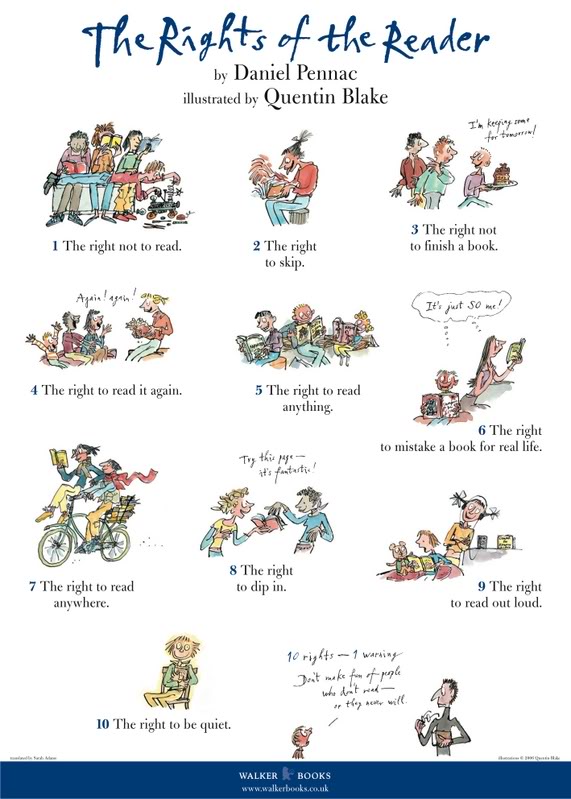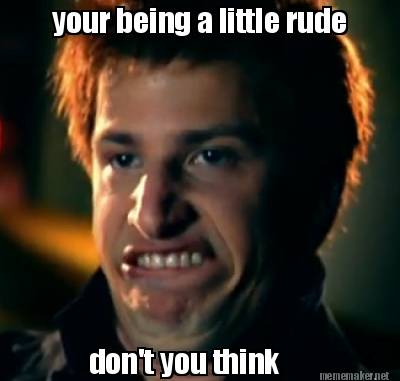Warning: This post is going to be about reading, and it is going to encourage you to read. You may need to go grab your spectacles.
While mindlessly scrolling through my Twitter feed, I recently saw this infographic by @grantdraws:
It not only had a great Quentin Blake-like look and style (compare it to the amazing “The Rights of the Reader” poster below), but it made me think about the important role that we have as teachers in fostering a reading culture in our classrooms and developing in our young ones a lifelong love of reading.

Most reading programs I’ve worked with are in agreement with the principle that kids have to love reading to want to do it often – although I did take a class in my teaching program that preached otherwise. The more kids read, the better they tend to achieve. The below infographic, which I found shared on usd343.net, is quite convincing for teachers, parents, and students alike:

As I am an elementary school classroom teacher that prescribes to a transdisciplinary approach to teaching and learning, I am charged with delivering instruction in all of the disciplines. The PYP model itself gives me the responsibility of teaching language, math, science, and social studies at a minimum, and it is very clear that all teachers in a PYP school are considered language teachers.
Back to the “Stages of the Reader” . . .
I personally have gone through all of the stages of this infographic, but I have stopped hoarding books due to the transient nature of international teaching. It comes down to the simple but sad fact that the more books I bring along, the more my shipping costs will be to schlep them all to my next country. Otherwise, I see myself and my reading journey in most of the other 8 stages, and I feel like I have a strong identity as a reader. I really hope that my love of reading and writing rubs off on my students – and if it doesn’t for some, usually offering the chance for them to build a reading fort if they read enough does the trick! 😜
Do teachers have to be readers?
Who am I to say who should be a teacher and who shouldn’t, but it might not be so controversial to say that you might not be made for teaching – especially if you are a reading teacher – if you don’t have a strong identity as a reader. This crosses over into the other disciplines as well. Should one be responsible for the future of our young mathematicians if one abhors math? Is it appropriate for a teacher to dive into a writer’s workshop with kids if he/she has never felt the urge to put pen to paper?

This post doesn’t mean to be provocative, but I would like your feedback. If a teacher is not a reader, can they truly succeed as a reading teacher by just faking it? Are there certain age levels that can “survive” a non-reading teacher, or certain disciplines where a strong reader’s identity is not necessary?
Let us know in the comments below, and keep on coming back to educationrickshaw.com for posts about teaching and education today, including a recent series called Why would anyone want to become a teacher?
And remember, it is never too late to start at Stage 1 of @grantdraws’s “Stages of the Reader”!




Oh yes! I am a reader absolutely!
And my love of reading has helped so much! I write too, and that really helps!
When we are teaching, reading a story to a class with vigour makes it come alive, and encourages the little ones to pick up books too! I love seeing my class imitating me reading a particular story!
And because I write too, I can give them examples of what and how
to create wonderful imagery with words, hopefully to instil that skill into the so they can do it themselves soon enough!
LikeLiked by 2 people
I’m so glad you agree! Thanks for the feedbacK 🙂
LikeLiked by 2 people
Have a great day!
LikeLiked by 1 person
Have you ever seen or read a book by Steven Layne? He is all about this. I recently heard him speak and he not only advocates for being a reader but to read aloud often to students (something that is lacking in upper grades). If we don’t model the habits of a reader then we aren’t really showing students how to read. Totally agree with your post! Love it!
LikeLiked by 2 people
Just looked him up – I’ll have to check him out more. Thanks for the comment 🙂
LikeLiked by 1 person
I agree! http://thatboycanteach.blogspot.co.uk/2016/08/being-reading-teacher.html
LikeLiked by 2 people
Thanks for commenting – and great article!
LikeLiked by 1 person
I’m an educator, but not a teacher (I’m an SLP). I am the mother of two boys whose fourth grade teacher was a voracious reader, and she ignited that spark in my children. She made exceptional recommendations for them, and they passed those on to me. My own book selections since their being in her class has changed. My boys still talk about her classroom library.
LikeLiked by 2 people
What a wonderful story 🙂 Thanks for sharing!!!
LikeLike
Fabulous post. Totally agree. Love the infographics. To be a teacher, one should love learning. A love of learning inspires others. Reading is essential to learning, and also inspires creativity and imagination. Should be in every teacher’s toolbox.
LikeLiked by 1 person
Dear Mr. Zach:
I noticed that both your dad and mom love to read and so do you!!
Keep sharing with others your love of reading because it’s like sharing an important part of us! Yes, teachers who read are the best!
Love,
Mom
LikeLiked by 1 person
Thanks mom!
LikeLike
Such an important topic! Lead by example! 👓📚
LikeLiked by 1 person
We agree! Thanks 🙂
LikeLike
Thanks so much! Can you change it to @MrZachG (with an h, not a k) for my Twitter handle. I love that you’re always reading our posts on educationrickshaw.com 🙂
LikeLike